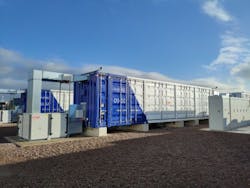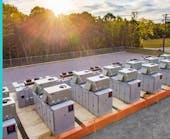Tightening the Battery Storage Supply Chain: Insights from Fluence Energy Manufacturing leader Pete Silveira
Made in America.
The phrase has been a passionate refrain for bringing manufacturing back to the U.S.—or a marketing tagline or a political rallying cry—and yet it’s never been that simple. Domestic supply chains can be made shorter, no doubt, but they also can prove more expensive and less efficient.
It’s been that way for decades despite the steady rumblings for bringing it all back home. What’s making the return to U.S. factories a reality are two more recent challenges: COVID-19 and the drive for an energy transition to lower carbon emissions.
Battery storage provider Fluence Energy recently became the latest to tighten up its supply chain by announcing it was opening new manufacturing supply chains closer to its North American market. Fluence announced a deal with an unnamed contract manufacturer in Utah to produce its Cube battery storage products.
The move made perfect sense from both financial and long-term vision viewpoints, Peter Silveira, Fluence’s senior director of manufacturing, said in an exclusive chat with EnergyTech.com.
“We’re trying to be more strategic because of supply chain disruptions, and this initiative allows us to be more flexible,” Silveira said. “This is the first wave (of what could be a series of regional contract manufacturing agreements globally) and we’ll see as demand increases.”
Market growth in the utility-scale battery storage sector is off the charts in the U.S., for sure. Battery storage capacity more than tripled last year to nearly 5 GW across more than 100 utility-scale projects.
Experts see global energy storage installation proceeding at a parallel pace as renewable wind and solar energy projects continue to be built. Whether it’s Texas or Taiwan, those weather-dependent energy resources need battery backup for balancing and extending the length of energy dispatch availability beyond when the sun shines and the wind blows.
Fluence was created several years ago when Siemens and AES Corp. combined some of their energy storage divisions. The new company is now publicly traded on the stock market.
Since then, Fluence has found acceptance in growing energy transition markets around the world.
Since it does not own or operate its own manufacturing sites, Fluence has focused on top tier contract manufacturers to do that work and get products such as the Cube out to customers that include both electric utilities, project developers and end users such as tech giants.
The higher cost of labor from U.S. manufacturing contractors is more than offset by the benefits of a tighter and more expert supply chain, Silveira noted.
“When we look at our manufacturing strategy, our mindset is on total cost of ownership (TCO),” he said. “What is the best value stream from a TCO perspective? What we see in our data is that while there may be more cost on the labor side, from the TCO perspective there is much more of a positive effect to do that.”
Fluence is not alone in making changes. The disruptions in supply chains from computer chips to food products certainly has been felt throughout the world. Whether it’s a new car or paper products, hurry up and wait has been an unwelcome, but constant presence in recent years.
There’s always been the worry that the American manufacturing workforce has been aging out or ignored by emerging technologies. Sure, they are attracted by high-paying jobs, but maybe they aren’t up to date on the type of work being done.
Nothing could be further from the truth, Silveira said.
“This is getting high traction. . . and we’re seeing a significant amount of candidates coming forward,” he pointed out.
Energy storage is striking a chord not only among companies wanting to smooth out their future, but also workers who want to be in on the next generation of technologies.
Fluence is bringing that future-forward group of U.S.-based factory workers completely up to date.
“My organization has solidified all of the training necessary” in producing Fluence Cubes and other products,” Silveira said. “We can cross-train both leadership and the direct workforce.”
Whether it’s for utility-scale or microgrid applications, industrial battery energy storage is hardly in its infancy. Fluence and its competitors are adept at integrating learned best practices and using those to speed the learning curve for those workers.
“It’s already blueprinted,” Silveira added. “We’re taking documentation and lessons learned and communicating to the new labor force. Our best practices and sequence of operations allows the new labor force to come up to speed very quickly.
Fluence Energy has been successful in deploying its technology all around the world, including recently announced projects in Taiwan, Portugal, Ireland and Australia. Only a few months ago, the company announced a deal with AES to utilize Fluence’s AI-powered IQ Bidding Application in maximizing the value of 1.1 GW in solar and storage capacity in the western U.S.
-- -- --
(Rod Walton, senior editor for EnergyTech, is a 14-year veteran of covering the energy industry both as a newspaper and trade journalist. He can be reached at [email protected]).






